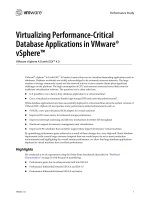Kivy interactive applications in python
Bạn đang xem bản rút gọn của tài liệu. Xem và tải ngay bản đầy đủ của tài liệu tại đây (1.66 MB, 138 trang )
www.it-ebooks.info
Kivy: Interactive Applications
in Python
Create cross-platform UI/UX applications and games
in Python
Roberto Ulloa
BIRMINGHAM - MUMBAI
www.it-ebooks.info
Kivy: Interactive Applications in Python
Copyright © 2013 Packt Publishing
All rights reserved. No part of this book may be reproduced, stored in a retrieval
system, or transmitted in any form or by any means, without the prior written
permission of the publisher, except in the case of brief quotations embedded in
critical articles or reviews.
Every effort has been made in the preparation of this book to ensure the accuracy
of the information presented. However, the information contained in this book is
sold without warranty, either express or implied. Neither the author, nor Packt
Publishing, and its dealers and distributors will be held liable for any damages
caused or alleged to be caused directly or indirectly by this book.
Packt Publishing has endeavored to provide trademark information about all of the
companies and products mentioned in this book by the appropriate use of capitals.
However, Packt Publishing cannot guarantee the accuracy of this information.
First published: September 2013
Production Reference: 1190913
Published by Packt Publishing Ltd.
Livery Place
35 Livery Street
Birmingham B3 2PB, UK.
ISBN 978-1-78328-159-6
www.packtpub.com
Cover Image by Aniket Sawant ()
www.it-ebooks.info
Credits
Author
Project Coordinator
Roberto Ulloa
Michelle Quadros
Reviewers
Proofreader
Anai Arroyo B.
Amy Johnson
Andrés Vargas González
Indexer
Javier de la Rosa
Monica Ajmera Mehta
Hugo Solis
Graphics
Acquisition Editor
Ronak Dhruv
James Jones
Commissioning Editor
Sruthi Kutty
Technical Editors
Ruchita Bhansali
Production Coordinator
Nilesh R. Mohite
Cover Work
Nilesh R. Mohite
Gauri Dasgupta
Monica John
www.it-ebooks.info
About the Author
Roberto Ulloa has a diverse academic record in multiple disciplines within the
field of Computer Science. He obtained an MSc from the University of Costa Rica
and also taught programming and computer networking there. He then spent two
years researching about cultural complexity at PhD level at the CulturePlex Lab of
the University of Western Ontario.
He loves travelling and enjoys an itinerant life, living among different cultures and
environments. He loves nature and has spent many months volunteering in Central
and South America.
He currently lives in Kuala Lumpur, earning a living as a web developer in
Python/Django and PHP/Wordpress. He constantly worries that the Internet has
already become aware of itself and we are not able to communicate with it because
of the improbability of it being able to speak Spanish or any of the 6,000 odd human
languages that exist in this world.
www.it-ebooks.info
Acknowledgments
I would like to thank Su, for not hesitating one second in encouraging and trusting
my ability to write this book; for believing in me and motivating me with endless
cups of coffee.
Javier de la Rosa, with whom I worked on my first Kivy project—the one that gave
birth to the blog post that caught the attention of my publishers.
My technical reviewers, Anaí Arroyo, Javier de la Rosa, Hugo Solís and Andrés
Vargas for their time and corrections.
My supervisor, Gabriela Barrantes, who has been a constant source of support and
inspiration throughout my academic life.
My family and friends, for whom this book will be a surprise, and who've paid with
the time that I didn't have to share with them.
The editorial personnel, for their patience in answering my questions.
Celina, for risking her Android to test my codes for the first time; for her constant
motivation, support, and criticism even though I disagree that my Space Invaders
look like bunnies and, if so, I still think they are terrifying space bunnies.
www.it-ebooks.info
About the Reviewers
Anaí Arroyo is a PMI certified Project Manager who loves software development
and is passionate about how technology can be used to improve the quality of
people's life and volunteering as a way to contribute to make a positive difference.
Over the last years, she has worked in the Education field, collaborating in the
design and development of Learning Management and Student Information
Management systems.
Andrés Vargas González is currently pursuing a Master of Science in Computer
Science through a Fulbright Fellowship at University of Central Florida (UCF). He
received a Bachelor's degree in the same field from Escuela Superior Politécnica del
Litoral (ESPOL) in Ecuador.
He is a member of the Interactive Systems and User Experience Lab at UCF.
His current research is on machine learning techniques to reduce the time on
gesture recognition in context. His previous works include enterprise multimedia
distribution and exploring usability of multi-touch interfaces in Information Systems,
which was tested on his DIY multi-touch surface. He is also interested in web
applications development. He implemented some e-commerce solutions as well as
Facebook applications in his home country and recently was working in the backend
of an educational data resource system in Florida, USA.
www.it-ebooks.info
Besides his academic and professional interests, he enjoys hiking high elevations,
learning from different cultures, biking by the city, and finally, playing and
watching soccer.
First and foremost, I would like to thank my four mothers for the
values, love, and inspiration I got from them every moment of my
life. I also wish to express my sincere gratitude to Shivani Wala for
providing me an opportunity to be part of this great project. At the
same time my special thanks to Michelle Quadros for keeping me
updated with the deadlines and any doubt I had. Last but not least I
wish to avail myself of this opportunity, express a sense of gratitude
and love to my relatives, professors, and friends.
Javier de la Rosa is a full-stack Python developer since 2005, when he first met
the Django web framework. During his years in Yaco, one of the main FLOSS-based
companies in Spain, he leaded the Research and Development Team, participating
in both European and national projects. Late in 2009, he started to collaborate with
The CulturePlex Lab for Cultural Networks research, at the Western Unviersity in
Canada, in his sparse time. As a result, he left Yaco in 2010 and joined the laboratory
to lead and supervise technical and software developments. Today, he is still in
charge of the developers team as well as conducting his own research on Big Culture,
where he mixes his background as a BA and MA in Computer Sciences, Logics and
Artificial Intelligence by the University of Seville, and his recent acquired skills
as a 3rd year PhD student in Hispanic Studies at Western University in Canada.
Currently, he just started his 1st year as a PhD in Computer Sciences, focusing on
Graph Databases and Query Languages.
A regular collaborator of Open Source projects, he is the owner and main
developer of qbe ( and neo4j-rest-client
( In the academic field, he
is author of several articles, as well as one of the writers of the book Programming
Historian 2 ( You can always contact him
on Twitter (@versae) or GitHub under the nickname versae.
www.it-ebooks.info
Hugo Solis is an assistant professor in the Physics Department at University
of Costa Rica. His current research interests are computational cosmology,
complexity and the influence of hydrogen on material properties. He has wide
experience with languages including C/C++ and Python for scientific programming
and visualization. He is a member of the Free Software Foundation and he has
contributed code to some free software projects. Currently, he is in charge of the
IFT, a Costa Rican scientific non-profit organization for the multidisciplinary practice
of physics. ()
I'd like to thank Katty Sanchez, my beloved mother, for her support
and vanguard thoughts.
www.it-ebooks.info
www.PacktPub.com
Support files, eBooks, discount offers
and more
You might want to visit www.PacktPub.com for support files and downloads related to
your book.
Did you know that Packt offers eBook versions of every book published, with PDF and
ePub files available? You can upgrade to the eBook version at www.PacktPub.com and
as a print book customer, you are entitled to a discount on the eBook copy. Get in touch
with us at for more details.
At www.PacktPub.com, you can also read a collection of free technical articles, sign up
for a range of free newsletters and receive exclusive discounts and offers on Packt books
and eBooks.
TM
Do you need instant solutions to your IT questions? PacktLib is Packt's online digital
book library. Here, you can access, read and search across Packt's entire library of books.
Why Subscribe?
• Fully searchable across every book published by Packt
• Copy and paste, print and bookmark content
• On demand and accessible via web browser
Free Access for Packt account holders
If you have an account with Packt at www.PacktPub.com, you can use this to access
PacktLib today and view nine entirely free books. Simply use your login credentials for
immediate access.
www.it-ebooks.info
www.it-ebooks.info
Table of Contents
Preface1
Chapter 1: GUI Basics – Building an Interface
7
Hello World!
8
Basic widgets – labels and buttons
11
Layouts14
Embedding layouts
18
Our Project – comic creator
22
Summary
28
Chapter 2: Graphics – The Canvas
31
Chapter 3: Widget Events – Binding Actions
51
Chapter 4: Improving the User Experience
77
Basic shapes
32
Images, colors, and backgrounds
38
Rotating, translating, and scaling
41
Comic creator – PushMatrix and PopMatrix
44
Summary48
Attributes, id and root
Basic widget events – dragging the stickman
Localizing coordinates – adding stickmen
Binding and unbinding events – sizing limbs and heads
Binding events in the Kivy language
Creating your own events – the magical properties
Kivy and properties
Summary
Screen manager – selecting colors for the figures
Color Control on the canvas – coloring figures
StencilView – limiting the drawing space
www.it-ebooks.info
52
54
59
62
67
69
72
75
78
81
84
Table of Contents
Scatter – multitouching to drag, rotate, and scale
Recording gestures – line, circles, and cross
Simple gestures – drawing with the finger
Summary
Chapter 5: Invaders Revenge – An Interactive Multitouch Game
Invaders Revenge – an animated multitouch game
Atlas – efficient management of images
Boom – simple sound effects
Ammo – simple animation
Invader – transitions for animations
Dock – automatic binding in the Kivy language
Fleet – infinite concatenation of animations
Scheduling events with the Clock
Shooter – multitouch control
Invasion – moving the shooter with the keyboard
Combining animations with '+' and '&'
Summary
Index
[ ii ]
www.it-ebooks.info
85
89
91
95
97
98
99
101
102
103
105
107
108
110
113
115
117
119
Preface
Mobile devices have changed the way applications are perceived. They have
increased in interaction types, the user expects gestures, multi-touches, animations,
and magic-pens. Moreover, compatibility has become a must-have if you want to
avoid the barriers imposed by major Operative Systems. Kivy is an Open Source
Python solution that covers these market needs with an easy to learn and rapid
development approach. Kivy is growing fast and gaining attention as an alternative
to the established developing platforms.
This book introduces you into the Kivy world, covering a large variety of important
topics related to interactive application development. The components presented
in this book were not only selected according to their usefulness for developing
state-of-the- art applications, but also for serving as an example of broader Kivy
functionalities. Following this approach, the book covers a big part of the Kivy library.
Instead of giving a detailed description of all the functions and properties, it
provides you with examples to understand their use and how to integrate the two
big projects that come with the book. The first one, the comic creator, exemplifies
how to build a user interface, how to draw vector shapes in the screen, how to bind
user interactions with pieces codes and other components related to improve the
user experience. The second project, Invaders Revenge, is a very interactive game
that introduces you to the use of animations, scheduling of tasks, keyboard events,
and multi-touch control.
Occasionally the book explains some technical but important Kivy concepts that are
related to the order and strategies used to draw in the screen. These explanations give
the readers some insights into the Kivy internals that will help them solve potential
problems when they are developing their own projects. Even though they are not
necessary for the comprehension of the main topics of this book, they will become
important lessons when the readers are implementing their own applications.
www.it-ebooks.info
Preface
The book keeps the readers attention by stating small problems and their solutions.
The sections are short and straightforward, making the learning process constant.
These short sections will also serve as a reference when they finish the book.
However, serving as a reference doesn't prevent the text from achieving the main
goal, which is teaching with bigger projects that connects the small topics. At the end
of the book, the readers will feel comfortable to start their own project.
What this book covers
Chapter 1, GUI Basics – Building an Interface, introduces basic components and layouts
of Kivy and how to integrate them through the Kivy Language.
Chapter 2, Graphics – The Canvas, explains the use of the canvas and how to draw
vector figures on the screen.
Chapter 3, Widget Events - Binding Actions, teaches how to connect the interactions of
the user through the interface with particular code inside the program.
Chapter 4, Improving the User Experience, introduces a collection of useful components
to enrich the interaction of the user with the interface.
Chapter 5, Invaders Revenge – An Interactive Multitouch Game, introduces components
and strategies to build highly interactive applications.
What you need for this book
This book requires a running installation of Kivy with all its requirements.
The installation instructions can be found at />gettingstarted/installation.html.
Who this book is for
The book aims at Python developers who want to create exciting and interesting
UI/UX applications. They should be already familiarized with Python and have a
good understanding of some software engineering concepts, particularly inheritance,
classes, and instances. That said, the code is kept as simple as possible and it avoids
the use of very specific Python nuances. No previous experience of Kivy is required
though some knowledge of event handling, scheduling, and user interface, in
general, would boost your learning.
[2]
www.it-ebooks.info
Preface
Conventions
In this book, you will find a number of styles of text that distinguish between
different kinds of information. Here are some examples of these styles, and an
explanation of their meaning.
Code words in text are shown as follows: "Missile and Shot inherits from the same
class called Ammo, which also inherits from Image. There is also the Boom class that
will create the effect of explosion when any Ammo is triggered."
A block of code is set as follows:
# File name: hello.py
import kivy
kivy.require('1.7.0')
from kivy.app import App
from kivy.uix.button import Label
class HelloApp(App):
def build(self):
return Label(text='Hello World!')
if __name__=="__main__":
HelloApp().run()
New terms and important words are shown in bold. Words that you see on
the screen, in menus or dialog boxes for example, appear in the text like this:
"Consider App as an empty window as shown in the following screenshot
(Hello World! output)".
Warnings or important notes appear in a box like this.
Tips and tricks appear like this.
[3]
www.it-ebooks.info
Preface
Reader feedback
Feedback from our readers is always welcome. Let us know what you think about
this book—what you liked or may have disliked. Reader feedback is important for us
to develop titles that you really get the most out of.
To send us general feedback, simply send an e-mail to ,
and mention the book title via the subject of your message.
If there is a topic that you have expertise in and you are interested in either writing
or contributing to a book, see our author guide on www.packtpub.com/authors.
Customer support
Now that you are the proud owner of a Packt book, we have a number of things to
help you to get the most from your purchase.
Downloading the example code
You can download the example code files for all Packt books you have purchased
from your account at . If you purchased this book
elsewhere, you can visit and register to have
the files e-mailed directly to you.
Errata
Although we have taken every care to ensure the accuracy of our content, mistakes do
happen. If you find a mistake in one of our books—maybe a mistake in the text or the
code—we would be grateful if you would report this to us. By doing so, you can save
other readers from frustration and help us improve subsequent versions of this book.
If you find any errata, please report them by visiting />submit-errata, selecting your book, clicking on the errata submission form link,
and entering the details of your errata. Once your errata are verified, your submission
will be accepted and the errata will be uploaded on our website, or added to any list
of existing errata, under the Errata section of that title. Any existing errata can be
viewed by selecting your title from />
[4]
www.it-ebooks.info
Preface
Piracy
Piracy of copyright material on the Internet is an ongoing problem across all media.
At Packt, we take the protection of our copyright and licenses very seriously. If you
come across any illegal copies of our works, in any form, on the Internet, please
provide us with the location address or website name immediately so that we can
pursue a remedy.
Please contact us at with a link to the suspected
pirated material.
We appreciate your help in protecting our authors, and our ability to bring you
valuable content.
Questions
You can contact us at if you are having a problem with
any aspect of the book, and we will do our best to address it.
[5]
www.it-ebooks.info
www.it-ebooks.info
GUI Basics – Building
an Interface
Kivy emerges as a successor of PyMT (a library for multitouch applications) with a
simple but ambitious goal in mind — same code for every commonplace platform:
Linux / Windows / Mac OS X / Macosx / Android / iOS (Mathieu Virbel, http://
txzone.net/2011/01/kivy-next-pymt-on-android-step-1-done/). This support
is being extended to Raspberry Pi thanks to a founding campaign started by Mathieu
Virbel, the creator of Kivy. Kivy was introduced in the EuroPython 2011, as a Python
framework designed for creating natural user interfaces.
So, let's start creating user interfaces using one of its fun and powerful components,
the Kivy language (.kv). The Kivy language helps us to separate the logic from the
presentation. This is a fundamental engineering concept that helps to keep an easy
and intuitive code. Nonetheless, it is possible to build a Kivy application using pure
Python and Kivy as a library. We will also learn those concepts in later chapters
because they allow us to modify interfaces dynamically.
This chapter covers all the basics for building a graphical user interface (GUI) in
Kivy. Afterwards, you will be able to build practically any GUI you have in your
mind, and even make them responsive to the size of window! The following is a list
of all the skills that you're about to learn:
• Launching a Kivy application
• The Kivy language
• Creating and using widgets (GUI components)
• Basic properties and variables of the widgets
• Fixed, proportional, absolute, and relative coordinates
• Organizing GUIs through layouts
• Tips for achieving responsive GUIs
www.it-ebooks.info
GUI Basics – Building an Interface
Apart from Python, this chapter requires some knowledge about Object-Oriented
Programming ( />concepts. In particular, inheritance ( />Inheritance_(object-oriented_programming)) and the difference between
instances ( />and classes ( will
be assumed. Before starting, you will need to install Kivy (The instructions can be
found in The book
examples were tested on Kivy 1.7.0 but a more recent version should work as well.
At the end of this chapter, we will be able to build a GUI starting from a pencil and
paper sketch. We will introduce the main project of the book — the Comic Creator,
and implement the main structure of the GUI.
Hello World!
Let's put our hands on our first code. The following is yet another Hello World
program:
1. # File name: hello.py
2. import kivy
3. kivy.require('1.7.0')
4.
5. from kivy.app import App
6. from kivy.uix.button import Label
7.
8. class HelloApp(App):
9.
def build(self):
10.
return Label(text='Hello World!')
11.
12. if __name__=="__main__":
13.
HelloApp().run()
[8]
www.it-ebooks.info
Chapter 1
This is merely a Python code. Launching a Kivy program is not different from
launching any other Python application. In order to run the code, you just have to
open a terminal (line of commands or console) and specify the command, python
hello.py --size=150x100 (--size is a parameter to specify the screen size). In the
preceding code, the lines 2 and 3 verify if you have the appropriate version of Kivy
installed in your computer.
If you try to launch your application with an older Kivy
version (say 1.6.0), an exception is raised for the specified
version. There is no exception raised if you have a more
recent version. Of course, backwards compatibility is desired
but not always possible, and so you might face problems if
you use a newer version.
We omit this statement in most of the examples inside the book, but you will be
able to find it again in the online codes, which you can download, and its use is
strongly encouraged in real life projects. The program uses two classes from the Kivy
library (lines 5 and 6): App and Label. The App class is the starting point of any Kivy
application. The following screenshot shows the window containing a Label with the
Hello World text:
Hello World Output
The way we use the App class is through inheritance. App becomes the base class
of HelloApp (line 8), the subclass or child class. In practice, this means that the
HelloApp class has all the properties and methods of App in addition to whatever we
define in the body (lines 9 and 10) of the HelloApp class.
In this case, the HelloApp's body just modifies one of the existent App's methods,
the build(self) method. This method returns the window content. In this case, a
simple Label saying Hello World! (line 10). Finally, the line 13 creates an instance
of HelloApp and runs it.
[9]
www.it-ebooks.info
GUI Basics – Building an Interface
So, is Kivy just another library for Python? Well, yes. But as part of the library, Kivy
offers its own language to separate the logic from the presentation. For example you
could write the preceding Python code in two separate files. The first file would then
include the Python lines as shown in the following code:
14.
15.
16.
17.
18.
19.
20.
21.
22.
23.
# File name: hello2.py
from kivy.app import App
from kivy.uix.button import Label
class Hello2App(App):
def build(self):
return Label()
if __name__=="__main__":
Hello2App().run()
The hello2.py code is very similar to hello.py. The difference is that the line 20
doesn't have the Hello World! message. Instead, the message has been moved to
the text property in the second file (hello2.kv) which contains the Kivy language:
24. # File name: hello2.kv
25. #:kivy 1.7.0
26. <Label>:
27.
text: 'Hello World!'
How does Python or Kivy know that these files are related? This is quite important
and tends to be confusing at the beginning. The key is in the name of the subclass of
the App, that is, HelloApp.
The initial part of the App's subclass name has to coincide with
the name of the Kivy file. For example, if the definition of the
class is class FooApp(App), then the name of the file must
be foo.kv and it must be in the same directory of the main file
(the one that executes the App's run() method).
Once that consideration is included, this example can be run in the same way we ran
the hello.py. We just need to be sure that we are calling the new main file (hello2.
py), python hello2.py -–size=150x100.
This is your first contact with the Kivy language, so let's go slowly. The #:Kivy
1.7.0 line of the hello2.kv code tells Python the minimal Kivy version that should
be used. The line does the same that the lines 2 and 3 did in the hello.py code. The
instructions that start with #: in the header of a Kivy language are called directives.
We will also be omitting the version directive along the book, but remember to
include it in your projects.
[ 10 ]
www.it-ebooks.info
Chapter 1
The <Label>: rule (line 26) indicates that we are going to modify the Label class
by setting 'Hello World!' in the text property (line 27). This code generates the
same output that was shown in the previous screenshot. There is nothing you can't
do using pure Python and importing the necessary classes from the Kivy library as
we did in the first example (hello.py). However, the separation of the logic from the
presentation results in simpler and cleaner code. Therefore, this book explains all the
presentation programming through the Kivy language, unless dynamic components
are added.
You might be worrying that modifying the Label class affects all the instances we
create from Label, because, they will all contain the same Hello World text. That
is true. Therefore, in the following section, we are going to learn how to directly
modify specific instances instead of classes.
Basic widgets – labels and buttons
In the previous section, we were already using the Label class, which is one of the
widgets that Kivy provides. Widgets are the little interface blocks that we use to set
up the GUI. Kivy has a complete set of widgets including buttons, labels, checkboxes,
dropdowns, and so on. You can find them all in the Kivy API kivy.uix (http://
kivy.org/docs/api-kivy.html) under the package kivy.uix.
It's a good practice to create your own Widget for your applications instead of using
the Kivy classes directly as we did in hello2.kv (line 26). The following code shows
how to do that through inheritance:
28.
29.
30.
31.
32.
33.
34.
35.
36.
37.
38.
39.
40.
# File name: widgets.py
from kivy.app import App
from kivy.uix.widget import Widget
class MyWidget(Widget):
pass
class WidgetsApp(App):
def build(self):
return MyWidget()
if __name__=="__main__":
WidgetsApp().run()
[ 11 ]
www.it-ebooks.info
GUI Basics – Building an Interface
In line 32 of the preceding code (widgets.py), we inherit from the base class Widget
and create the subclass MyWidget, and, in line 37, we instantiated MyWidget instead
of modifying the Kivy Label class directly as we did in hello2.py. The rest of the
code is analogous to what we covered before. The following is the corresponding
Kivy language code (widgets.kv):
41. # File name: widgets.kv
42. <MyWidget>:
43. Button:
44.
text: 'Hello'
45.
pos: 0, 100
46.
size: 100, 50
47.
color: .8,.9,0,1
48.
font_size: 32
49. Button:
50.
text: 'World!'
51.
pos: 100,0
52.
size: 100, 50
53.
color: .8,.9,0,1
54.
font_size: 32
Notice that now we are using buttons instead of labels. Most of the basic widgets in
Kivy work in a very similar manner. In fact, Button is just a subclass of Label that
includes more properties such as background color.
Compare the notation of line 26 (<Label>:) of hello2.kv with the line 43 (Button:)
of the preceding code (widgets.kv). We used the class notation (<Class>:) for the
Label (and for MyWidget) but another notation (Instance:)
for Button. We just defined that MyWidget has two instances of Button (on line
43 and 49), and then we set the properties of those instances (the color is in RGBA
format that stands for red, green, blue, and alpha/transparency).
The size and pos properties consist of fixed values, that is, the exact pixels on
the window.
Notice that the coordinate (0, 0) is at the bottom-left
corner, that is, the Cartesian origin. Many other languages
(including CSS) use the top-left corner as the (0, 0)
coordinate, so be careful with this.
[ 12 ]
www.it-ebooks.info









